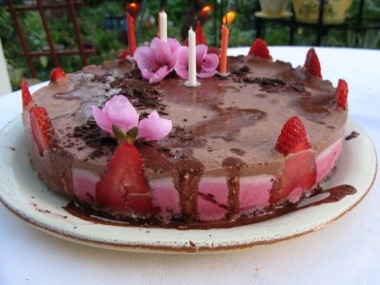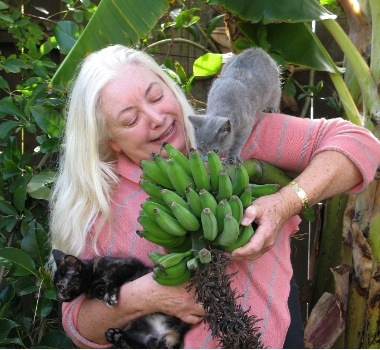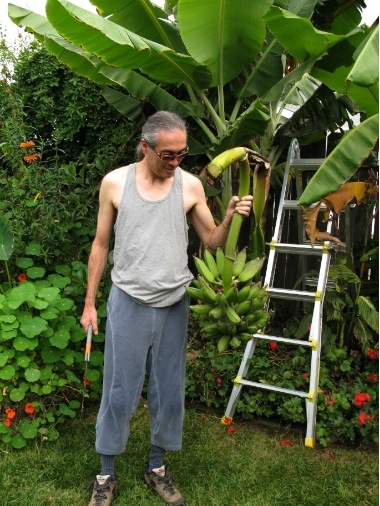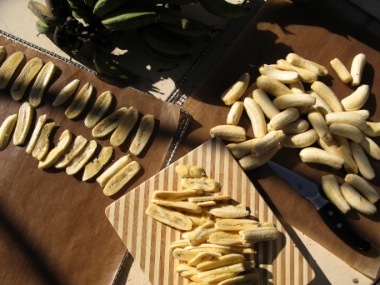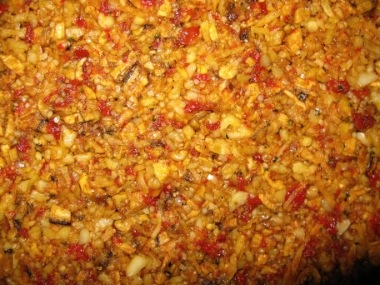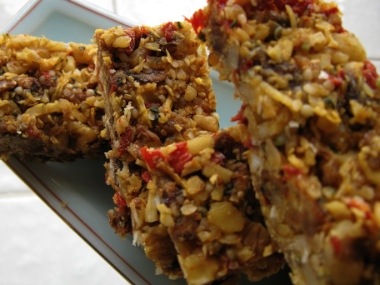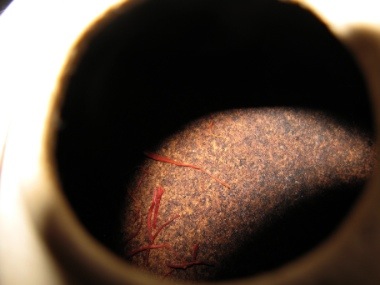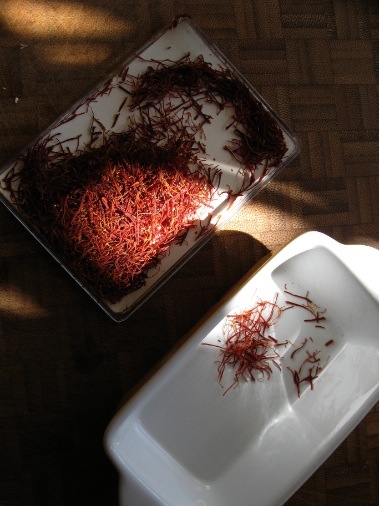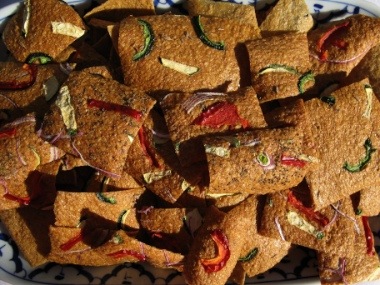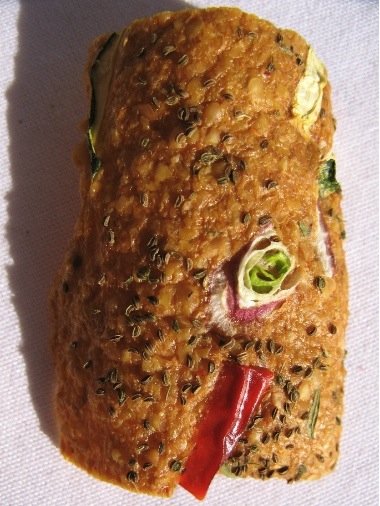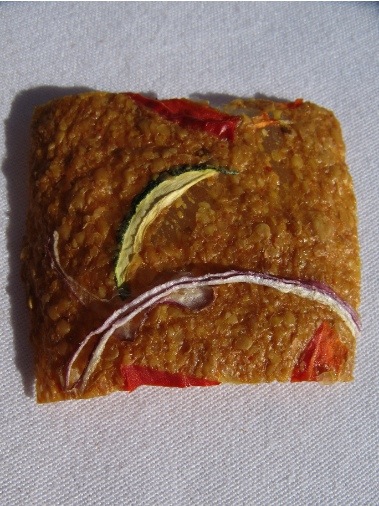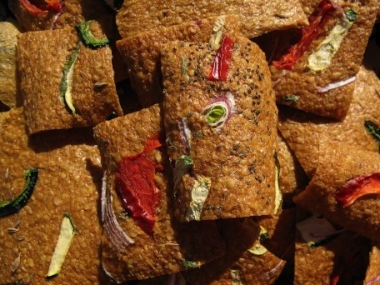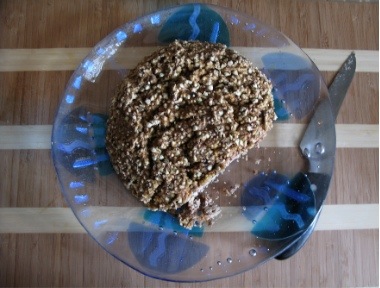I am finding that as well as a learning curve in raw food preparation there are other, more profound, shifts.
My sense of time is altered, and it noticeably affects other parts of my life. Raw food preparation is different than the buy, prep, cook, eat, clean up time line for eating cooked food. With raw food, sometimes the preparation begins days ahead, with soaking and sprouting. Dehydrating can take a couple of days if one wants to keep the enzymes intact. When a lunch or dinner item calls for some aspects to be pre-made, one must have thought that out previously. One slips more into The Long Now way of thinking about time. The granola I make takes me about a week of soaking sprouting and dehydrating many separate items before it is complete. Not a lot of time every day, but the process does sit on the dash board of consciousness with a check list of items to be added. This calls for a broader view, like a slower heart beat, to the day and to the week, and to the season.
With cooked food the question is always what is the best way to cook this? what temperature? what else needs to be cooked with it?
With raw food, the question is always How can I bring more LIFE to this food? Will soaking or sprouting or chopping bring out the life in it? Can I keep the dehydrating temperature low enough to ensure that its enzymes are still intact? Can I melt the cacao butter slowly enough so that the temperature is not raised too high? These are gentle questions. There is time and encouragement to breathe, and to think, while preparing raw food.

I'm thinking about learning and inspiration. A great example has just shown itself. I began to make a bruschetta from a recipe, and somehow, between the trip to the panty and answering the phone, I find myself making the mixture not from the recipe, but from the list of ingredients that appears on the bottle of organic bruchetta we bought at the farmer's market.
Huh!
I think of the people at the Mt. Olive stand at the farmer's market in Ojai. Their farm is in Paso Robles.
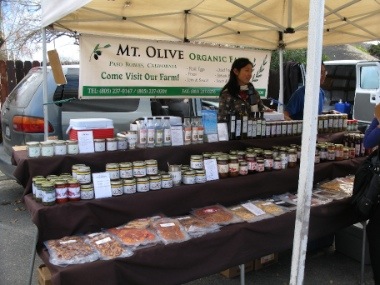
I am inspired by what they are doing and by how they are combining their families (three families), their passion, their faith and their hard work to make the land into an abundant paradise. Everything is organic and everything at their stand is made in the farm kitchen from their organic produce.
If you stop by the stand, you are invited to taste everything from little wooden sticks that they dip into their sample jars then hand to you. How to choose? Everything is fresh, organic, raw and delicious.
They tell us about their farm and answer questions about their worm beds which is how they create great soil for their plants and trees.
The first treats we bought were dehydrated persimmon slices, persimmon leather and persimmon/walnut bars.
Theses were delicious. We had never tasted fuyu persimmon before. The next week we caught the end of the persimmon season and bought a basket full of persimmons. We were Inspired.
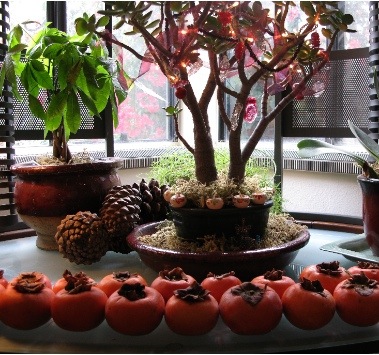
I lined the persimmons up near the window sill, more to look at them than anything.
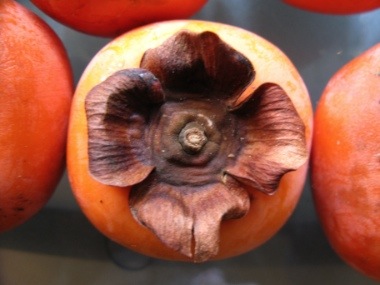
Then I made our own leather, dried slices and a walnut persimmon bar that we liked better than the Mt. Olive Farm bar...without sugar the bar was sweet enough for us! The next week there were no more persimmons at the market.

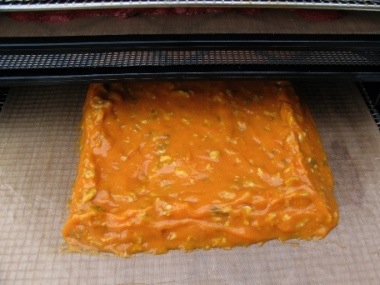 For some reason, the only photo I took of the walnut bar was as it was going in to the dehydrator, ( I know....it doesn't look as good as it tasted at this point in its life). Laer it was cut it into bars. How exciting it is to discover a new fruit.
For some reason, the only photo I took of the walnut bar was as it was going in to the dehydrator, ( I know....it doesn't look as good as it tasted at this point in its life). Laer it was cut it into bars. How exciting it is to discover a new fruit.
We planted a persimmon tree in the front yard. We learned that the best one would be a pollination constant, non astringent fuyu.

We tasted our first persimmon on a little sample stick on January 10 and by February 20th we were planting our own tree. We were inspired and we brought that inspiration into our lives. Learning happened.
A few years ago, my friend Yaanna told me about a book she was reading. She told me that when British soldiers were getting ricketsand scurvey at sea, Ligurian sailors were eating the food their wives had sent with them and the sailors were returning home healthy. Questions about food preservation in the days before refrigeration and canning burst into mind.
The British sailors just had limes from the tropics to keep them from scurvy and rickets. The Ligurians had a whole culture of good food. I spent two years getting up every day and wondering, in this season, what can I make that would last on a long journey? I imagined Liguria, the kitchens, their cookwear, the utensils.....I never read the book, but this inspiration, this wondering, led me into fermenting vegetables in all kinds of ways, making cheeses and non alcaholic fermented drinks, preserving food in oil, preserving by dehydrating, sauces in bottles (small necks topped with oil or wax, then corked).
I still haven't read the book. I don't even remember the name. The inspiration leading to all those imaginings created a learning environment that went far beyond where any recipe could take me. I had a whole Ligurian village in my head that I could stop in at any house to see what was cooking, to hear stories of the day and find out when the ships were coming home. This acted like a file folder for information I would glean in the rest of my day and store there. From this, food inventions would appear.
We are working our way through the Mt. Olive line and enjoying every treasured bottle we bring home.
Here is the bruschetta I've made from enjoying theirs. Before I was eating raw food, I thought of bruchettas as roughly chopped mix to put on bread. Now that we don't have bread to soak up the tomato juice, I'm happy to have this version, where I use half dehydrated tomatoes. Mine is made from colourful heritage tomatoes, four colours here, each with a different flavour. ( Organic Brandywine, Yellow pineapple, Green Zebra Heritage tomatoes and Organic Roma tomatoes ( to make the fourth colour). Mine is quite different, but the inspiration?
I'll take the inspiration given, (Thank You Mt. Olive friends), and I'll taste, imagine and learn.














